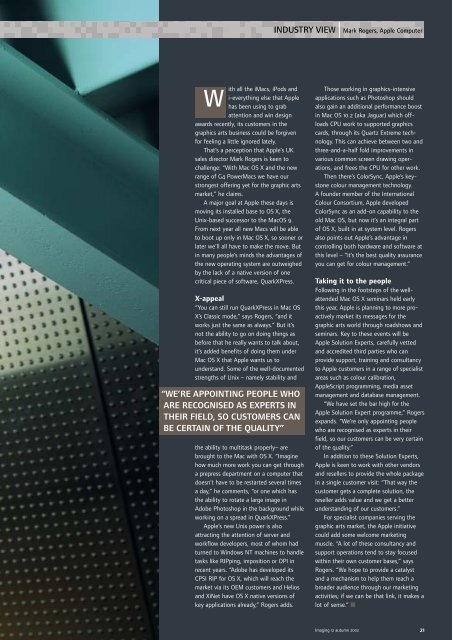Imaging 12 - Fujifilm Graphic Systems
Imaging 12 - Fujifilm Graphic Systems
Imaging 12 - Fujifilm Graphic Systems
You also want an ePaper? Increase the reach of your titles
YUMPU automatically turns print PDFs into web optimized ePapers that Google loves.
W<br />
ith all the iMacs, iPods and<br />
i-everything else that Apple<br />
has been using to grab<br />
attention and win design<br />
awards recently, its customers in the<br />
graphics arts business could be forgiven<br />
for feeling a little ignored lately.<br />
That’s a perception that Apple’s UK<br />
sales director Mark Rogers is keen to<br />
challenge: “With Mac OS X and the new<br />
range of G4 PowerMacs we have our<br />
strongest offering yet for the graphic arts<br />
market,” he claims.<br />
A major goal at Apple these days is<br />
moving its installed base to OS X, the<br />
Unix-based successor to the MacOS 9.<br />
From next year all new Macs will be able<br />
to boot up only in Mac OS X, so sooner or<br />
later we’ll all have to make the move. But<br />
in many people’s minds the advantages of<br />
the new operating system are outweighed<br />
by the lack of a native version of one<br />
critical piece of software, QuarkXPress.<br />
X-appeal<br />
“You can still run QuarkXPress in Mac OS<br />
X’s Classic mode,” says Rogers, “and it<br />
works just the same as always.” But it’s<br />
not the ability to go on doing things as<br />
before that he really wants to talk about,<br />
it’s added benefits of doing them under<br />
Mac OS X that Apple wants us to<br />
understand. Some of the well-documented<br />
strengths of Unix – namely stability and<br />
“WE’RE APPOINTING PEOPLE WHO<br />
ARE RECOGNISED AS EXPERTS IN<br />
THEIR FIELD, SO CUSTOMERS CAN<br />
BE CERTAIN OF THE QUALITY”<br />
the ability to multitask properly– are<br />
brought to the Mac with OS X. “Imagine<br />
how much more work you can get through<br />
a prepress department on a computer that<br />
doesn’t have to be restarted several times<br />
a day,” he comments, “or one which has<br />
the ability to rotate a large image in<br />
Adobe Photoshop in the background while<br />
working on a spread in QuarkXPress.”<br />
Apple’s new Unix power is also<br />
attracting the attention of server and<br />
workflow developers, most of whom had<br />
turned to Windows NT machines to handle<br />
tasks like RIPping, imposition or OPI in<br />
recent years. “Adobe has developed its<br />
CPSI RIP for OS X, which will reach the<br />
market via its OEM customers and Helios<br />
and XiNet have OS X native versions of<br />
key applications already,” Rogers adds.<br />
INDUSTRY VIEW Mark Rogers, Apple Computer<br />
Those working in graphics-intensive<br />
applications such as Photoshop should<br />
also gain an additional performance boost<br />
in Mac OS 10.2 (aka Jaguar) which offloads<br />
CPU work to supported graphics<br />
cards, through its Quartz Extreme technology.<br />
This can achieve between two and<br />
three-and-a-half fold improvements in<br />
various common screen drawing operations,<br />
and frees the CPU for other work.<br />
Then there’s ColorSync, Apple’s keystone<br />
colour management technology.<br />
A founder member of the International<br />
Colour Consortium, Apple developed<br />
ColorSync as an add-on capability to the<br />
old Mac OS, but now it’s an integral part<br />
of OS X, built in at system level. Rogers<br />
also points out Apple’s advantage in<br />
controlling both hardware and software at<br />
this level – “it’s the best quality assurance<br />
you can get for colour management.”<br />
Taking it to the people<br />
Following in the footsteps of the wellattended<br />
Mac OS X seminars held early<br />
this year, Apple is planning to more proactively<br />
market its messages for the<br />
graphic arts world through roadshows and<br />
seminars. Key to these events will be<br />
Apple Solution Experts, carefully vetted<br />
and accredited third parties who can<br />
provide support, training and consultancy<br />
to Apple customers in a range of specialist<br />
areas such as colour calibration,<br />
AppleScript programming, media asset<br />
management and database management.<br />
“We have set the bar high for the<br />
Apple Solution Expert programme,” Rogers<br />
expands. “We’re only appointing people<br />
who are recognised as experts in their<br />
field, so our customers can be very certain<br />
of the quality.”<br />
In addition to these Solution Experts,<br />
Apple is keen to work with other vendors<br />
and resellers to provide the whole package<br />
in a single customer visit: “That way the<br />
customer gets a complete solution, the<br />
reseller adds value and we get a better<br />
understanding of our customers.”<br />
For specialist companies serving the<br />
graphic arts market, the Apple initiative<br />
could add some welcome marketing<br />
muscle. “A lot of these consultancy and<br />
support operations tend to stay focused<br />
within their own customer bases,” says<br />
Rogers. “We hope to provide a catalyst<br />
and a mechanism to help them reach a<br />
broader audience through our marketing<br />
activities; if we can be that link, it makes a<br />
lot of sense.” ■<br />
<strong>Imaging</strong> <strong>12</strong> autumn 2002 21



